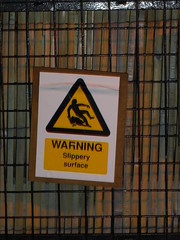In the 1990s, my brother Bob worked in the Vancouver film industry as a production assistant. At that time, he was in the “young worker” category (15 to 24 years old) and eager to please. In that job, he could be replaced with a moment’s notice. One of his friends had been fired for buying the wrong type of doughnut.
Bob told me about an experience that makes me angry to think about because it’s so dangerous. Thankfully he wasn’t hurt, but it’s still a good example of worst practices.
“I once stood on a slippery roof holding a piece of plywood while a massive snow gun shot fake snow at me to create the illusion of winter,” he told me via Facebook, in answer to my question: “What’s the most dangerous thing you’ve ever been asked to do at work?”
“It was almost impossible, but took every ounce of strength I had to not go flying,” he said. “I think weird stuff like that happens all the time in film because there’s a sort of unwritten thing relating a bit to ‘the show must go on’ or ‘whatever it takes’ mentality in that part of the arts.”
Improved standards for safety in film
Today in BC, we have Actsafe, the health and safety association for British Columbia’s motion picture and performing arts industries. I’m sure the folks at Actsafe would not be happy to see what my brother was asked to do at work. It makes me angry to think of him in that situation, not wanting to lose his job, and doing something so dangerous. He left the industry years ago, but for the many who remain, I hope they are not put in such hazardous positions.




Hi Susan,
Many thanks for mentioning Actsafe on your blog. Unfortunately, we do still hear stories like the one your brother shared. He has correctly identified one of the major obstacles we’re working to remove in our quest to improve health and safety in the film and performing arts industries.
In fact, it was one of the main reasons we brought together supervisors and department heads in the film industry on February 5 for “A Conversation that Matters” (see post “Planting a seed for a safer future at http://t.co/BEn26pl) Using a ‘world cafe’ format, we asked leaders in the industry to discuss ways to bring about a culture of safety in the film industry.
The story you tell was, unfortunately, an all-too-familiar theme that day. But if we think back to the implementation of seatbelt laws, anti-smoking legislation etc., it really did take a cultural shift to get us where we are today on those issues. There’s work to do, but there are certainly influential people in the film industry to help lead that change.
We know there’s a lot to consider with respect to health and safety in our industries — not to mention quite a few regulatory agencies in the mix. One of our main tasks is to help people working in film and performing arts make sense of it all. There’s almost always a way to do things safely and still put together a great production. So, if you work in the industry and need help, please call us.
Newsletter sign-up: http://www.actsafe.ca/resources/newsletters/
Thanks once again, Susan, for the important work you do with this blog and for sharing your brother’s story.
Thanks to Actsafe for commenting and offering help to folks in this industry. I’d like to write more about safety in Vancouver productions, so let me know if you have any stories – especially best practices.